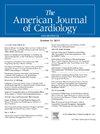OPT-RATE AF 的原理和设计:针对射血分数保留型心力衰竭提高生理起搏率的随机临床试验。
IF 2.1
3区 医学
Q2 CARDIAC & CARDIOVASCULAR SYSTEMS
引用次数: 0
摘要
房室结(AVN)消融治疗持续性心房颤动(AF)后进行心脏生理性起搏(CPP)可改善射血分数降低和保留射血分数的心力衰竭(HFpEF)患者的治疗效果。新的证据表明,高射血分数心力衰竭患者可从较高的心率中获益,但房室结消融术后的最佳起搏率仍是未知数。OPT-RATE AF 是一项前瞻性随机交叉研究,研究对象是因持续性房颤接受房室结消融术(NCT06445439)的高射血分数(HFpEF)患者。研究将招募约 60 名房颤和房室结消融、CPP 以及左室射血分数≥50% 的房颤患者。参与者将按 1:1 的比例被随机分配到起搏率下限为 60 次/分 (bpm) 的环境中 3 个月,然后切换到 80 次/分的起搏率环境中 3 个月,反之亦然。主要终点是通过 6 分钟步行测试评估运动能力的变化。显著的次要结果包括堪萨斯城生活质量问卷(KCCQ-12)、肌酐和钠尿肽的变化以及临床事件。每个阶段都将记录患者死亡率和高血压住院情况。将在基线、3 个月和 6 个月时记录心电图、超声心动图、起搏器检查以及主要和次要结果。研究正在进行注册,预计将于 2026 年完成。OPT-RATE AF 是一项随机临床试验,将确定对房室结消融和/或 CPP 后的持续性房颤和高房颤患者提高起搏率的效果。研究结果将有助于深入了解时变在改善生活质量和其他重要心血管预后方面的作用。本文章由计算机程序翻译,如有差异,请以英文原文为准。
Rationale and Design of OPT-RATE AF: A Randomized Clinical Trial of Increased Physiologic Pacing Rates in Heart Failure With Preserved Ejection Fraction
Cardiac physiologic pacing (CPP) after atrioventricular node (AVN) ablation for persistent atrial fibrillation (AF) has improved outcomes in patients with heart failure with reduced and preserved ejection fraction (HFpEF). Emerging evidence suggests patients with HFpEF benefit from higher heart rates, yet the optimal pacing rate after AVN ablation remains unknown. Optimal Pacing Rate for cardiac resynchronization therapy after atrioventricular node ablation in persistent Atrial Fibrillation and heart failure (OPT-RATE AF) is a prospective, randomized crossover study of patients with HFpEF after AVN ablation for persistent AF (NCT06445439). Approximately 60 patients with AF and AVN ablation, CPP, and HF with left ventricular ejection fraction ≥50% will be enrolled. Participants will be randomly assigned 1:1 to a pacing lower rate limit of 60 beats/min for 3 months and then switched to a rate of 80 beats/min for 3 months and vice versa. The primary end point is the change in exercise capacity assessed using the 6-minute walk test. Notable secondary outcomes will include changes in the Kansas City Quality of Life Questionnaire (KCCQ-12), creatinine and natriuretic peptide, and clinical events. Patient mortality and HF hospitalizations will be recorded at each phase. Electrocardiogram, echocardiogram, pacemaker interrogation, and primary and secondary outcomes will be recorded at baseline, 3 months, and 6 months. Study enrollment is ongoing and estimated to be completed by 2026. OPT-RATE AF is a randomized clinical trial that will determine the effect of a higher pacing rate in patients with persistent AF and HFpEF after AVN ablation and/or CPP. Study findings will provide insight on the role of chronotropy in improving quality of life and other important cardiovascular outcomes.
求助全文
通过发布文献求助,成功后即可免费获取论文全文。
去求助
来源期刊

American Journal of Cardiology
医学-心血管系统
CiteScore
4.00
自引率
3.60%
发文量
698
审稿时长
33 days
期刊介绍:
Published 24 times a year, The American Journal of Cardiology® is an independent journal designed for cardiovascular disease specialists and internists with a subspecialty in cardiology throughout the world. AJC is an independent, scientific, peer-reviewed journal of original articles that focus on the practical, clinical approach to the diagnosis and treatment of cardiovascular disease. AJC has one of the fastest acceptance to publication times in Cardiology. Features report on systemic hypertension, methodology, drugs, pacing, arrhythmia, preventive cardiology, congestive heart failure, valvular heart disease, congenital heart disease, and cardiomyopathy. Also included are editorials, readers'' comments, and symposia.
 求助内容:
求助内容: 应助结果提醒方式:
应助结果提醒方式:


